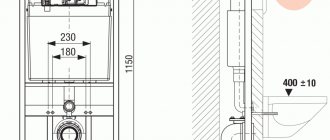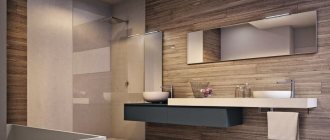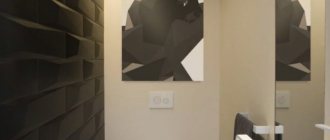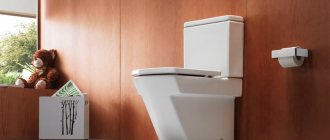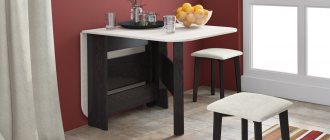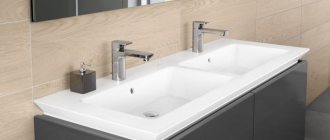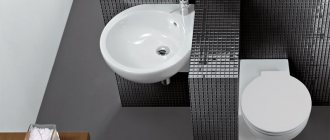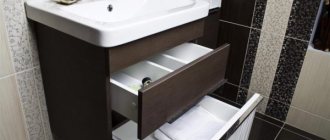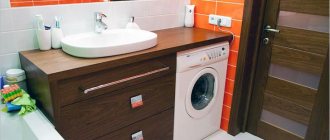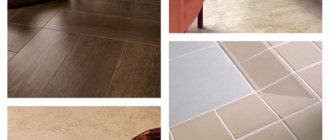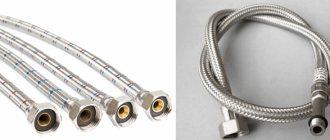Which flooring to choose
For the ergonomics of the bathroom, it is very important to choose the right flooring. The floor should not be slippery as this may lead to accidents
The main types of materials used in bathrooms and toilet rooms are:
Tiles in the toilet
- Non-slip ceramic tiles;
- Laminate;
- Linoleum.
You need to choose very carefully. It should have a slightly rough structure so that it does not slip when wet. Typically, Italian ceramic tiles are of much higher quality than domestic ones and have a longer service life. Tile flooring has many advantages:
- This coating is abrasion-resistant and can be washed and cleaned without fear;
- Moisture resistance;
- Durability;
- Beautiful appearance.
There is only one drawback - ceramic tiles are afraid of mechanical damage; you cannot drop various objects on them, as they can deteriorate irrevocably.
By choosing laminate for your bath, you get a beautiful floor covering that can imitate expensive wood. Even a novice master can install laminate in a bathroom, the main thing is to fit the joints well. If the joints are poorly fitted, then moisture can get into them and the laminate will be deformed and damaged. It is advisable to lay special mats on top of the laminate; such a coating becomes slippery when exposed to water.
Linoleum bathroom
You can lay linoleum in the bathroom. This flooring is inexpensive, beautiful, is not afraid of moisture, and is easy to lay on the floor. However, when wet, linoleum is very slippery, so it is also necessary to use special bathroom mats.
Heated floors in bathrooms have proven themselves well, this is especially true for combined toilets with a bathtub. Such floors are pleasant to walk on with bare feet and do not require an additional source of heating in the room.
How to rationally equip a bathroom
In a modern home, be it a standard apartment or a private house, there is always both a bathroom and a toilet room, or a combined version of them. In most cases, they are not too large, but it is quite possible to allocate the necessary space for a sanitary area and a bathing area. Before purchasing plumbing fixtures, you need to measure the area of the room and determine the locations for the sink, bathtub and other equipment, taking into account the recommended rules and regulations for their installation.
It is recommended to install the bidet next to the toilet, at a distance of at least 60 cm.
When organizing space in the bathroom, you should take into account ergonomics and observe rational placement. It is necessary to determine in advance and accurately the maximum comfortable distance between the toilet and the bidet. There are no clear regulations on the size of this distance; its choice is quite arbitrary, but it must be taken into account that the distance from the sewer riser to the toilet is 1 m, and the rest of the plumbing is placed no further than 3 m.
It is advisable to make the free distance in front of each device at least 60 cm (an area of 70x100 cm will be more convenient), and on each side you need to leave 25-30 cm. The direct distance between the bidet and the toilet, according to the advice of experts, can be made from 30 cm to 45 cm A shorter distance will not be enough to use plumbing, and a larger distance will not be very convenient. From the appliances to the washbasin, if it is provided in a sanitary area, there is a gap of at least 25 cm.
Sink to the rescue
The space under the sink should also not be ignored. In a combined bathroom, this option is especially relevant. Since when placing plumbing fixtures in the corners of the room, it is not always possible to add a separate cabinet or bedside table for storage. For convenience, the space under the sink should be equipped with retractable grilles, storage pockets, various holders or hooks should be hung on the doors.
18. Under-sink storage
19. You can hide a lot of items here
Distance from the wall to the toilet optimal layout
During the renovation of a toilet and bathroom, when replacing plumbing fixtures, the problem of proper bathroom layout arises. One of the most important convenience parameters is the distance between the toilet and the wall, since if it is chosen incorrectly, using the device will be uncomfortable.
We will look at the regulatory requirements and find out what specific basic distances are determined by the instructions.
Bathroom remodeling
Separate toilet placement
Let's start with a simpler case, when the toilet is separated from the bathroom. It is simpler due to the fact that in such a toilet, in most cases, there is one device. In a larger package, it is possible to add a bidet, if the size of the room allows it.
We will immediately announce the standards for the distance from the wall to the toilet, adopted in SNiP 2.08.01-89 * “Residential buildings”:
Note! Official standards are mandatory for public and private construction of objects. Apartment owners will be able not to make them and place the devices at their own discretion, since their operation and maintenance are carried out by them
I would like to state that these standards are relevant in the case when the toilet is quite spacious, and you do not understand where it is better to put this or that device. But in most post-Soviet apartments this problem does not arise, since the dimensions of the toilet are minimal, and the toilet is placed in the middle of the cubicle near the back wall.
Note! Most of the Soviet-era toilet stalls have dimensions such that installing the compact exactly in the middle of the room near the back wall gives the very minimum distances to the side walls and the front door. Combined bathroom
Combined bathroom
If the toilet and bathroom are in the same room, the task is a little complicated by the fact that you need to rationally place a couple of plumbing fixtures in a fairly small room.
Additional troubles may result from the need to install household appliances - washing machine, boiler, etc. Along with this, the most acceptable layout option involves not only rational and ergonomic, but also harmonious placement of all objects from a design standpoint.
This is another feature of modernity: people want to live comfortably and beautifully, and this, as we know, cannot be prohibited.
If the bathroom is large, then you need to divide its premises into areas: the area of the shower or bathtub, the area of the washbasin, the area of the toilet, etc. But in most Soviet and many modern apartments there is no room for freedom, and the task comes down to meeting the minimum requirements for the distance between neighboring devices, devices and walls and the presence of passages.
Quite often, a compact and a bidet, and from time to time a washbasin, are placed in a line against the wall. In this case, there should be a gap of at least 20 cm between adjacent devices, preferably 30 cm. This means the distance from edge to edge.
If there is a sink next to the toilet, and it is also approached from the side of the appliance, then you must not forget about the space for tilting: while washing, a person leans towards the sink and moves back a little. The minimum space for this should be at least 70 cm.
Note! The dimensions of the distances to the side walls are taken without transformations - 38 - 45 cm from the middle axis of the bowl to the wall. Similarly, the requirement for the distance in front of the toilet does not change - it is at least 53 cm, for comfortable use - 76 cm
Here it is possible to make adjustments only on a large scale.
For combined bathrooms, the issue of saving space is very relevant. One example of such savings is a toilet with a tank in the wall. Installing this model with your own hands is complicated, but the use of modern installations and kits with frames simplifies this task.
When remodeling bathrooms and restrooms, take into account the distances between adjacent devices, and do not forget about the distances from the wall (see also the article “Bidet toilet: purpose and design features”).
Ergonomics of the bathroom and toilet rooms
13.03.2009 17:54
(60 ratings, average: 4.17 out of 5)
To My World
Every time a renovation is planned, it is necessary to start with the so-called wet areas - the bathroom, toilet and kitchen. These rooms are the most difficult when planning and calculating ergonomic space.
When reconstructing (repairing) a bathroom, the necessary conditions are taken into account, namely:
- The toilet must be located near the sewer riser; if this is not taken into account, then the toilet is placed above the floor level.
- The sink must be placed at a height of 85-90 cm from the floor level.
- In small bathrooms (less than 15 m2), for safety reasons, it is prohibited to install sockets and switches; they are located in front of the entrance to the room.
- In cases where the bathroom is more than 15 m2, you can install sockets for various equipment: heated towel rails, hair dryers, saunas, TVs and even electric fireplaces.
- Heated towel rails are located next to the riser for connecting to hot water. Electric heated towel rails can be installed at any height from the floor and next to an outlet.
Choosing plumbing fixtures for a combined bathroom with toilet
In the room for sanitary procedures, the bathroom is not used so often; most often, the tap above the sink is opened to wash hands. It can be swivel-out if installed with an open flexible hose. This is the best solution when there is no separate space for a toilet and washbasin.
To connect modern plumbing, you should use only new pipes and hoses. This will ensure long-term performance of each part.
If we talk about the materials of the bathing container, then here too the huge variety is striking. It is suggested to choose:
- glass bath;
- acrylic;
- wooden (the so-called “dugout” made from natural material);
- cast iron with legs;
- steel;
- with imitation of natural stone;
- container with a door (convenient for family members with limited mobility of limbs);
- transfer tank (for disabled people, with lift);
- a sit-down or multi-level bath (it is convenient to wash the child while sitting);
- Jacuzzi with additional options including bubble massage.
If you want to purchase products with the highest possible resistance to mechanical and chemical damage, then composite or marble materials will be the right choice.
Shower stalls are also presented in a wide range - in format, tray depth and equipment. Many people like corner models with sliding doors, which save room space.
When choosing a toilet, be sure to pay attention to the angle of the sewer pipe. It should become the main criterion.
Warm floor
They can be either electric or flexible pipes with hot water. The connection and control panels for the electric floors are placed in front of the door to the bathroom.
Toilets
There are floor-standing ones with a tank (compacts), floor-standing ones with a built-in tank, hanging ones, and also combined with a bidet. Wall hung toilets require additional space to install the flush cistern into the wall.
| Optimal dimensions of a floor-standing toilet | Optimal washbasin sizes |
Bidet
There are floor and hanging ones. It is better to buy complete with a toilet, to maintain the style and shape of the same design (in wall-hung kits, all communications must be hidden under one panel). The bidet is installed next to the toilet at a distance of 15-20 cm.
Sinks
There are ceramic, glass, steel, acrylic, stone and wood. According to the type of fastening, they are divided into console sinks attached to the wall with brackets, standing on a stand (tulip type) and built-in sinks. The standard sink depth is 45 cm. The length of double sinks is 120-150 cm. The distance between the sink and the shower cabin is or the bathroom must be at least 30 cm.
| Necessary optimal sizes for washing in the bathroom |
| Necessary optimal dimensions for towel drying in the bathroom |
Baths
There is a wide variety of bathtubs made from different materials: Cast iron. They heat up quickly and retain heat for a long time. Such baths are not subject to corrosion. The only limitation is the design; there are no other shapes other than rectangular. Steel. Durable surface, but does not hold heat well. Acrylic (plastic). Such baths are durable, but do not retain heat. They come in a variety of shapes and sizes. Quarilic (a mixture of acrylic with quartz powder). Holds heat well, durable and scratch resistant. There are also Wooden, Onyx, Marble and Steel bathtubs. In terms of functionality, there are regular and hydromassage bathtubs. The choice of bathtub depends on the size of the bathroom. There is a direct relationship between the height and length of the bathtubs - the longer they are, the lower their height. Common bathtub sizes are 170x70 cm. There are also sitz bathtubs with lengths of 150x70 and 120x70 cm.
| Standard dimensions of a rectangular bathtub | Standard sizes of a round bathtub |
| Standard sizes of corner bathtubs | |
Shower cabins
There are shower cabins of various shapes and sizes. They are divided into simple and combined. Simple ones come with a tray of various shapes and glass or plastic door walls. Trays in shower cabins can be: ceramic, steel, cast iron, acrylic, marble chips. The minimum size of a shower tray is 80x80 cm. Combined shower cabins are combined hydromassage baths with a shower cabin. They significantly save space in the bathroom.
| Various options for placing plumbing fixtures in bathrooms |
| Various options for placing plumbing fixtures in showers and toilet rooms |
| Next > |
Updated (03/14/2009 20:50)
Super small bathrooms - 40 original ideas
When planning to renovate a small bathroom, many are faced with the problem of how to place all the necessary plumbing in a cramped space. Which one? Of course, first of all, a toilet with a sink and faucet, secondly (as the highest priority option) - a shower stall, a shower corner, or install curtains (doors) in a niche. If the bathroom space is less than 1.4 x 1.4 m (2 sq.m.), you can’t even dream of a bathtub. I wonder if it is possible to accommodate all the necessary plumbing fixtures in an even smaller area? It turns out it is possible! And the designers and developers of so-called car caravans (car camping sites) or, more simply, mobile homes on wheels have succeeded in this. In general, you are amazed at the genius of seemingly simple ideas, thanks to which you can plan and compactly place everything that will make a family of 3 feel comfortable.
Check out one of the options for compact placement of a kitchen, bathroom and sleeping area in a standard minivan. Everything is calculated to centimeter precision. There is everything necessary for living and good rest.
With trailers there are even more possibilities for planning specific zones. Depending on their purpose, the length of the trailer may vary. In principle, this is the same small house, but you can park it in the right place and enjoy all the delights of life.
A bathroom for car camping consists of modules and, depending on the manufacturer and model, its equipment may vary. There are various options for placing plumbing fixtures, but it all comes down to one thing - compactness and maximum functionality. Necessary communications are of no small importance. Since this is a mobile option, it has its own nuances for saving water consumption, electricity, storage and waste disposal.
Basically, the option is used when the bathroom floor with a drain for draining water is a kind of shower tray. Why a bathroom, because it has all the necessary plumbing - a toilet, bathroom furniture or sink, faucet, shower with shower head. This option is very convenient, allows you to significantly save space and is often used in southern countries, especially in Southeast Asia. From a hygiene point of view, there are also advantages, since when you take a shower, you can wash and clean the plumbing fixtures, walls and floors with water. But there is one thing... all plumbing must be 100% waterproof. Some Chinese manufacturers produce interesting models of shower cabins (boxes) with different sizes and layouts, inside of which all the necessary plumbing is located. This option is often used in places where it is not possible to create a bathroom. But at present, such models are quite expensive and not everyone can afford to buy them. The floor in the bathrooms of camping cars can be covered with linoleum, moisture-resistant laminate or other finishing materials. In this case, the shower cabin or shower enclosure includes a shower tray, which can be low or high. Having curtains or thick curtains to protect the room from splashes would be the best solution.
In the layout of a car bathroom at home, as in an airplane toilet, all useful centimeters are used. Everything should be placed very compactly and any free space should be rationally used.
As a rule, toilets are used of the rotating type, which is also important for comfort. If there is no need, the main bowl turns to the side and does not interfere with taking a shower, for example. Please note that in the photo above the sink there is a mono command mixer with a pull-out shower head and this is also an element of maximum functionality. Therefore, the mixer can be used for its intended purpose, as a sink mixer and additionally, as a shower head and as a hygienic shower.
Is it possible to accommodate all the necessary plumbing fixtures in a bathroom area of 1.5 square meters? Of course yes! See how a “folding” sink is a perfect space saver. One can only envy the originality of the developers. In this case, even the toilet can be used as a toilet seat, which is also very convenient when taking a shower. A shower tray is used as the floor.
Also quite compact and stylish option with a folding sink located above the toilet. The width of the bathroom is only 0.9 m. length 1.4 m. Area 1.3 sq.m. The floor is again used as a shower tray. Pay attention to the folding curtains, which can be unfolded at an angle of 90 degrees and they will reliably protect the room and the front door from splashes.
Another very original option, when the sink is installed on an axis and it is possible to rotate it 180 degrees. In this case, the shower head will be used as a sink faucet and for other purposes. The sink easily slides into the wall cavity along with the siphon and corrugated connecting pipe.
Any space is used as intelligently as possible. Bathroom furniture with a countertop is located at a 90 degree angle. and has three doors. All necessary household chemicals, various supplies and accessories will fit inside. This option uses a 100mm increased height pallet.
Stainless steel sinks are often used in car camping. They can be regular, corner or built into furniture.
Look at other photos with options for compact arrangement of plumbing fixtures and other elements of super small bathrooms. Perhaps they will be the beginning of your idea on how to most rationally convert a small room into a bathroom.
Number of impressions: 18292
Find out even more
Shower niche in the bathroom - 12 layout options
Feel free to plan a niche in your bathroom that will make it stylish, cozy and functional.
Bathroom layout with bath and shower - 12 best solutions
Feel free to use the unique opportunity to install a bathtub, shower cabin and all other plumbing fixtures at the same time.
Bathroom and toilet in 3D (Modern style with an area of 2.7 sq.m. +0.96 sq.m.)
Evaluate the bathroom and toilet in 3D visualization (Modern style with an area of 2.7 sq.m. and 0.96 sq.m.)
Photo tiles (photo panels) in the bathroom interior
Who could previously imagine a charming landscape with the sea and tropical plants on the wall in the bathroom, and a piece of the beach on the floor?
Return to list
SNiP norms 2.08.01-89
Until recently, the Russian Federation mainly used the standards of the Soviet state, which paid great attention to the construction, industrial, epidemiological and occupational safety of its citizens
Recognizing the appropriateness of the data presented in these documents, obtained not just empirically, but also on the basis of scientific research, the norms and rules were still used at the level of recommendations.
The court took them into account when resolving disputes, but could also ignore them. The creation of a state register of regulatory recommendations, norms and rules, as well as methodological guidelines led to the fact that the developed norms and rules in the field of construction, production and the national economy acquired the status of official and legally enshrined
The main condition for acceptance was compliance with the norms of Russian law
The creation of a state register of regulatory recommendations, norms and rules, as well as methodological guidelines led to the fact that the developed norms and rules in the field of construction, production and the national economy acquired the status of official and legally enshrined. The main condition for acceptance was compliance with the norms of Russian law.
Sanitary and hygienic standards (SanPiN) are not only not outdated, but have become even more relevant due to the deteriorating epidemiological and environmental situation. None of the adopted sets of rules, according to the laws of the Russian Federation and regulations of the Ministry of Health, should conflict with the standards of sanitation and hygiene.
sizes and distances
Designers, doctors and manufacturers of bathroom equipment have long been paying attention to
bathroom ergonomics. The results of numerous studies have made it possible to determine the sizes of equipment suitable for 90% of people and its rational placement
The remaining 10%, who have larger dimensions, have to either endure the inconvenience or increase the numbers by purchasing larger showers and leaving more space between the elements of the bathroom.
Unfortunately, bathrooms are often so small that ergonomics can only be a dream. However, it is worth at least approximately adhering to the rules, taking into account the available opportunities. Ideally, 75 cm of free space should be left between each piece of plumbing equipment, as well as between the equipment and the wall/door.
This does not apply to toilets and bidets.
should be approximately
35 to 45 cm
. If you leave a long distance, it can be inconvenient.
Distance from shower stall or bathtub to sink
can also be reduced
to 30 cm
, but no less than that.
The washbasin bowl should be above the floor at a height of 80-110 cm
. Ideally, 90 cm, unless, of course, the bathtub is used by people of average height.
, the height of the countertop of bathroom furniture should be the same.
(tables, cabinets, chests of drawers, sink holes, etc.).
If children do not have their own bathroom, you need to take care of a comfortable bench so that the child can easily perform hygiene procedures while looking at his reflection in the mirror.
When washing at the sink, a person bends over, which means that there should be enough space in front of the sink for this. You cannot install a washbasin in a tight nook if there is no free space of at least 55 cm
.
However, there should be enough space so that a person, when washing his face and brushing his teeth, does not rest his elbows on the walls.
As for the toilet, there should be at least 35-45 cm to the right and left of it - no matter whether there are walls or other pieces of equipment. There should be at least 50 cm in front of the toilet, regardless of what is located there - a door, a shower stall or a sink. It is better if at least 75 cm is left in front of the toilet
If this is a toilet stall, then its average size should be 168 by 92 cm
Better if in front of the toilet
At least 75 cm
will be left .
If this is a toilet stall
, then its average size should be
168 by 92 cm
.
It needs to be mounted slightly in front of the edge of the toilet (20-30 cm)
.
The height of the toilet paper holder
from the floor is
60-70 cm
.
If a stationary shower corner
, then its size should be
at least 75 by 75 cm
, and this is provided that people of average build will take a shower.
Ideally, a shower corner or shower stall
should be
at least 90 by 90 cm
.
Expert advice
In order for plumbing fixtures to fit harmoniously into the interior design of the bathroom, you need to carefully look through the catalogs and take a closer look at the various models. In this case, the following parameters must be taken into account:
- When placing plumbing fixtures, it is recommended to leave at least 60 cm of free space in front of the toilet and at least 20 cm at the edges (right and left). It is believed that such a gap between devices is most convenient for using them.
- If the bathroom has a washbasin, then it is installed at a height of 80-85 cm from the floor (this height is optimal for people of different heights). The recommended free space in front of the bathtub and sink is at least 70 cm.
Obviously, there are actually a great many options for equipping a small bathroom, making it ideal from the point of view of having the necessary functional appliances in it and corresponding to the main design idea of the interior. The main thing is not to overdo it and stick to the same style in the apartment and bathroom.
SNiP Residential buildings on distance standards
The rules contained in the regulatory document are mandatory for the construction of any type of building - industrial, public, medical, educational and residential. However, there is an unspoken opinion that owners of premises in residential buildings and private buildings can deviate from the dictated standards if they themselves carry out their maintenance and operation.
Basically, such a retreat is made by the owners of premises with bathrooms, combined or frankly small. If the toilet is spacious enough, it is better to adhere to the established rules in order to use special rooms with convenience and safety:
- to the front (front) wall or wall with a door, if we are talking about a small toilet, the minimum distance is 53 cm. This is enough to not feel tightness in the knee joint;
- the maximum required distance from the frontal plane located in front of the seated person is 76 cm;
- the maximum distance from the front does not particularly need to be regulated, and if possible, the functional zone for a person can be more than a meter;
- from the middle axis of the toilet to the side wall, the established minimum is 40 cm. In some sources it is defined as 38 cm;
- the optimal distance from the central axis of the toilet is 45 cm. This is enough for comfortable operation of the plumbing fixture. But no one forbids installing at a greater distance, if the parameters of the allocated room allow it;
- in a separate toilet, the distance between the toilet and the wall on the left in standard buildings is usually equal to the distance to the wall on the right side;
- The location of the toilet in the toilet room is usually the center of the room, because the sewer pipe is supplied here. This also determines the position of the remaining toilets on the riser on the floors above and below;
- The second option for placing plumbing equipment is closer to the back wall. This does not make it possible to equip some kind of shelves or rack, but it is typical for the minimum dimensions of the toilet in apartments of standard construction, where the bathroom is separate;
- The toilet stall in Soviet-era houses was built according to size, when the central placement provided the necessary distances to the side wall and front surface with the entrance door located in it.
When arranging a shared bathroom, there are certain conditions that must be observed. These are standards for the distance of the toilet from other interior items that should be adhered to, even minimally.
But this is not a suitable option if the dimensions of one of the family members do not correspond to the average figures for which the building codes and standards are calculated.
Other installation details
As you can see, there are many nuances and problems hidden in installing a toilet. The distance from the wall in this case is no less important an indicator than others, so experts recommend planning this kind of work in advance so as not to forget about anything and do everything in accordance with the standards.
Please note that when lifting the toilet above the base of the floor, it is not recommended to use wood for this purpose, since this material is susceptible to rotting as a result of the adverse effects of condensation. Having moved the plumbing fixture to an acceptable distance from the wall to the side of the toilet (the numbers are indicated above) and mounted the device, it is recommended to pour a concrete screed, which additionally requires the use of screws, dowels and special fasteners for plumbing fixtures
Only in this way will the device be securely fastened, and you can enjoy the comfortable use of plumbing without worrying about breakage
Having moved the plumbing fixture to the permissible distance from the wall to the side of the toilet (the numbers are indicated above) and mounted the device, it is recommended to pour a concrete screed, which additionally involves the use of screws, dowels and special fasteners for plumbing fixtures. Only in this way will the device be securely fastened, and you can enjoy the comfortable use of plumbing without worrying about breakage.
Now you know what rules and regulations to use. The distance from the wall to the toilet is an important indicator that makes daily visits to the toilet easier and more comfortable. When faced with the need for redevelopment, studying this kind of material will help you avoid common mistakes that are so often made by repairmen who have started redevelopment on their own.
Why the bathroom should be ergonomic
The toilet is one of the most in-demand rooms in any home. The use of various plumbing fixtures should be safe and practical, and the overall decor of the toilet room should be pleasing to the eye. If all the rules for arranging plumbing fixtures are followed and the repairs are carried out in accordance with the standards, then using the bathroom will be comfortable and convenient.
In the process of renovating a bathroom, in order for the resulting room to be functional and comfortable, it is necessary to follow certain rules that determine the minimum dimensions of plumbing fixtures and the distances between individual pieces of equipment. The space in this room will be organized in such a way that all planned devices will fit in it, in addition, you will be able to use them freely and comfortably. The main and irreplaceable devices, of course, are the toilet and sink. You must plan the placement of furniture and shelves correctly. Often in this room it is also necessary to find a place for a washing machine.
If you have already decided which pieces of furniture, fixtures and equipment will be placed in the bathroom, you can start planning their location, taking into account the correct distances. Before you begin planning the interior design of a bathroom, you need to know the distance from the toilet to the wall, the standards that are established in order to comply with sanitary and hygienic requirements, as well as to ensure convenience when using plumbing fixtures.
Interior of a bathroom combined with a toilet: 10 photos of successful projects
A small bathroom needs proper organization of the workspace, especially if it needs to be converted into a combined bathroom. This room will perform several functions simultaneously, so the corresponding zones should be located as conveniently as possible. It is recommended to use methods to expand usable space.
Universal budget design option Source aa-mirrors.co.il
It is important to choose ergonomic furniture and non-standard plumbing fixtures. It is advisable to use the corners of the room. For example, install a corner shower stall or a sit-down bathtub in one of them, and install a sink or toilet or some piece of furniture in the other. The range of plumbing products today is large; you can easily choose a miniature sink, corner toilet, stall or bathtub.
Installing a corner toilet to save space in a small room Source instasaver.org
The color scheme of the room must be thought out in advance. It is recommended to decorate a small space in light colors (gray-beige, white or blue). It is advisable to make the walls in a small combined bathroom glossy; this will improve lighting and visually expand the room.
Simplicity and practicality Source fujifilm.jp
In a bathroom with an area of less than 3.5 sq.m. It is advisable to zone the space. Replace the bath with a shower or make a sector for taking water procedures, limited by a glass partition, and install the toilet and sink separately.
It is important that the partition is transparent and the floor surface does not differ in color. This technique will create the illusion of integrity, that is, visually the space will not be “cut” into separate parts.
Design of a chic bathroom with a shower cabin Source vizada.ru
In a combined bathroom, a bath or shower cabin usually takes up a lot of space. Instead, you can seal the area of the floor and wall in the shower area and install a low pan. Make the floor with a slope to drain water and lay it out with tiles. These actions will allow you to use the space of the room as profitably as possible and visually expand the space of the bathroom.
Shower room with toilet in chocolate colors Source italstroy.ru
A spacious shower cabin is suitable for a married couple who prefers to take water procedures together. This is also a good option for an elderly person who finds it difficult to get out of the bath on his own. A transparent partition would also be appropriate here, allowing you to visually enlarge the room. To enhance the effect, the bathroom can be decorated with a large mirror.
Black, gray and white in bathroom design Source charismadesignstudio.com
Every bathroom, even the smallest one, needs places to store useful little things. There are many options: open shelves, wall niches, tall cabinets, cabinets with doors and drawers. Things that are afraid of water should be hidden in closed drawers, and shampoos and gels should be placed at hand, beautifully displayed on shelves.
Convenient plasterboard shelves decorated with yellow tiles Source moyavanna.com
In a combined bathroom you need to use any area of usable space. If it is not possible to install compact corner cabinets, you can use the space under the sink. It is advisable to place a cabinet or drawer there for storing towels and cosmetics. The cabinet doors should be equipped with hooks and pockets, and the inside should be equipped with retractable grilles.
Sink above the washing machine to save small space Source prostroyer.ru
A mirror is necessary in the interior of any bathroom, especially a small one. This decorative item is used both in the singular and in the plural (for example, a set of several elements gradually decreasing in size). A good idea would be mirrored doors on a wall cabinet or sliding door system. Such furniture will visually expand the space of a small bathroom and add light.
Functional shelf above the sink with lighting Source houzz.com
Bathroom lighting
An ergonomic toilet or combined bathroom is characterized by good and practical lighting. Built-in light bulbs look good, as well as additional light sources that illuminate individual areas. There must be a small lamp near the washbasin that will provide good illumination for the person washing. Above the bathroom, the light should be more diffused and soft so that you can relax after a hard day at work. It’s good when the bathroom has economical night lighting, which will allow you to use the room without turning on the main light.
Lighting for a combined bathroom
Methods for modernizing a separate bathroom also include modern approaches to lighting. It doesn’t matter how many square meters the room is, 2 or 20, you can always organize an original concept that combines advantageously:
- general and local lighting;
- fluorescent lamps and diodes;
- sun rays and artificial light.
A standard layout and strict decoration can decorate even a small bathroom.
It is possible, without changing the plumbing and wall cladding, to improve the bathroom with the help of one lighting design. This is a diode strip around the perimeter of the ceiling and separate luminous squares behind the glass above the bathtub.
Note! An important condition for rooms with high humidity is excellent sealing.
You can use local lighting as a way of zoning - separately use diodes to mark the countertop under the sink and the wall cabinet with a mirrored door. Designers offer many interesting concepts that are easy to implement in your bathroom.
An ideal solution for small spaces would be wall-hung sinks, the space under which can be used for cabinets.
Average social standards
Standards for installing a toilet away from the wall are the results of measurements, studies, social and statistical surveys that allow us to develop standards for continuous production. Some of them were included in GOSTs and SanPiN and became standard standards for the sale of industrial products in construction markets and building materials supermarkets.
The children's toilet was developed according to standards obtained in pediatrics, where there are standard standards for each age - weight, height. Children who do not meet age standards have to adapt to any preschool educational institution - be it a kindergarten or a school.
At home, not everyone has the extra square meters and funds to install a special device. It is much more rational to use a special toilet stand. Social standards concern standardized equipment and room size.
If there are people who do not meet these parameters, they are inconvenienced or (if they have significant funds) they create toilets and buy custom toilets. The average size standards are as follows:
- The most common toilet size: bowl height - 40 cm, tank - 81.5 cm, drain pipe rises 185 cm. The compact itself is most often 65 cm long and 35 cm wide. It follows that from the central axis of the device to its edges can be at least 17.5 cm, if this is an adult and not a child’s version. Then it is clear why on a construction forum, when asked how many centimeters should be the minimum distance, they write that it can be 38 cm, and the distance from the toilet to the side wall is at least 20 cm. In total, 17.5 cm (almost 18 cm) from the central (longitudinal) axis of the bowl and 20 cm recommended to the wall, and give those 38 cm (minimum). And if you follow the SNiP standards and make 45 cm from the axis to the wall, then this will be the optimal average parameter, convenient for most people.
- For a toilet room, according to building regulations, 80 cm in width and 1 m 20 cm in length are considered sufficient for a comfortable stay and the exercise of natural needs. When converting old secondary housing, the length and width are often made smaller. Sometimes in this way meters are gained in the hallway or kitchen. In this case, they usually bring the bathroom and toilet closer together or expand the space by changing the layout of the bathroom and installing a shower stall. But in houses of mass standard construction with a separate toilet, there is often a size determined by GOST and SNiP, corresponding to SanPiN standards and providing maximum convenience to people living in the apartment.
The nuances of installing a toilet
The minimum distance from the toilet in the front part cannot be less than 53 cm, otherwise the discharge of natural needs will become problematic and cause harm to health. The optimal functional space in the front part is 75 cm. It is not limited in the direction of increasing it, but if this is not possible in a combined bathroom, then a toilet with a tank in the wall or wall-hung is used.
Equipping a combined bathroom according to existing needs is particularly difficult in a small apartment. In this case, they resort to installing a shower instead of a bathtub and draw up a scheme in which none of the devices will block access to the other during operation or, at least, cause minor inconvenience.
These standards are easily met when using standard designs and types of sinks, bidets, toilets, and washbasins. But if you purchase something unusual, an exotic shape or unusual dimensions, you need to take careful measurements so as not to experience difficulties during installation or not to be left with new equipment, the installation of which will be impossible under existing conditions.

